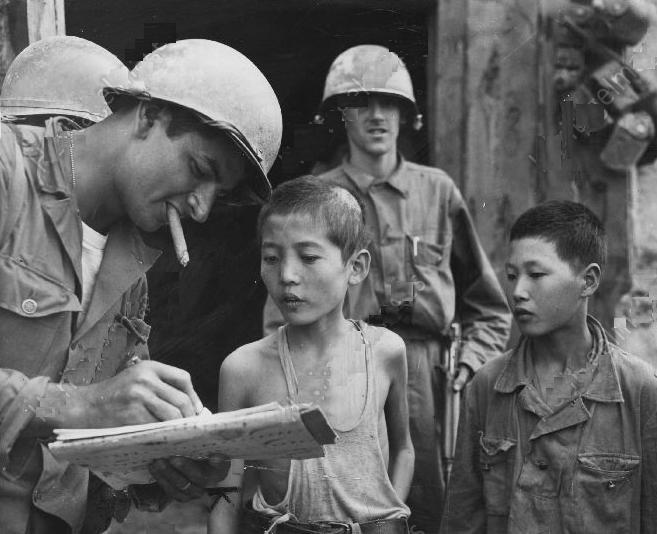
The Korean War: Prisoners of War

Figure 1.--Here American GIs interogate two NKPA child soldiers. The boys were captured by elements of the 2nd batallion, 38th Infantry Rgiment, 2nd Infantry Division. Th photograph was taken as the Americans had launched the Inchon landings (September 18, 1950). It is unclear how much military training they had received. After the first year of fighting durung which the conflict raged up and down the peninsula from Pusan to the Yalu, the front stabilized t aboutvwherevit began--the 39th parallel. The major issue in negotiating the cease fire were the POWs.
|
|
Most of the soldiers captured during the Korean War wer South Korean, North Korean and Chinese. We are not sure what the North Korean policy was toward POWs at the onset of the War when they invased South Korrnd swpt south. We know that units simply shot men they captured rather than taking them captive. One such incident occurred furing the battle of Taejon--the Chaplain–Medic massacre (July 16, 1950). North Korean soldiers murdered 30 unarmed, critically wounded United States Army soldiers and an unarmed chaplain. Just how common this was and how captured South Korean soldiers were treated we cannot yet say. There were itger such incidents. The best known is the Hill 303 massacre. Historians today generally agree that these killings were not ordered by the North Korean commanders. The question of course arises as to whu so manu unit commanders has no scruples about killing unarmed captives, even criticlly wounded men. American inteligence intercepts found that North Korean commanders, concerned about how prisoners were being treate, establoished stricter guidelines for handling th men captured. This was difficult to enforce in the chaos of th U.N. offensive followung th Inchon landings. Desperate and retreating men were actually more prone to take recenge on POWs as well as civiliams. [Appleman. p. 350.] We do not know if any North Koreans were ever punished for by their government for war crimes. Not do we know if the Chinese Communist Army after they intervened behaved any differently. Some 5,000 U.N. POWs, mostly Americans, but also British, Turkish, and Australian POWs) were taken by the Comminists, primarily early in the War during the initual Chinese intervention. They were kept by the Chinese Army at Pyoktong POW camps. These camps (five cluster units) were locatead near Pyoktong, North Korea, near the borderline between China and North Korea. The major issue in the peace talks becme the repatriation of the Communist POWs. The Communists demanded that all Korean and Chinese POWs be returned, even the ones who did not want to be repatriated. There was a POW uprisings at Koje-do. The Communists eventually accepted the voluntary repatriation, but only if the majority of the POW's would return to China or North Korea. This did not, however prove to be the case. North Korean and Chinese negotgistors found this embarassing as they claimed tht thy had created worker paradises. Many Coomunist POWS, both North Koreans anbd Chinese, refused to be repatriated. The negotiations and thus the War continued until the Communists eventually agreed to drop the issue. The repatiated U.N. POWs reported mistreatment and abuse including torture.
Sources
Appleman, R.E. South to the Nakong, North to the Yalu (Washington D.C. Department of the Army, 1961/1998).
CIH

Navigate the Children in History Website:
[Return to Main Korean War page]
[Return to Main specific war and crisis page]
[Return to Main early Cold War period page]
[Return to Main Korean history page]
[Introduction]
[Animals]
[Biographies]
[Chronology]
[Climatology]
[Clothing]
[Disease and Health]
[Economics]
[Geography]
[History]
[Human Nature]
[Law]
[Nationalism]
[Presidents]
[Religion]
[Royalty]
[Science]
[Social Class]
[Bibliographies]
[Contributions]
[FAQs]
[Glossaries]
[Images]
[Links]
[Registration]
[Tools]
[Children in History Home]
Created: 3:59 AM 2/14/2015
Last updated: 3:59 AM 2/14/2015



